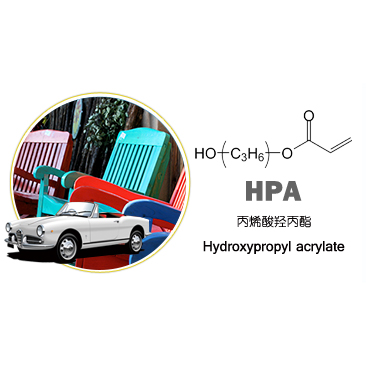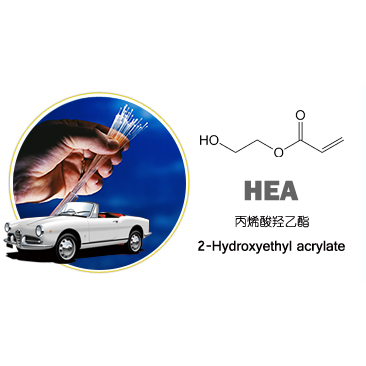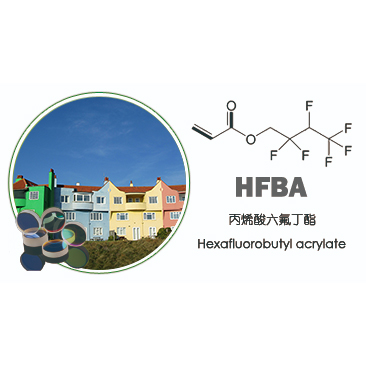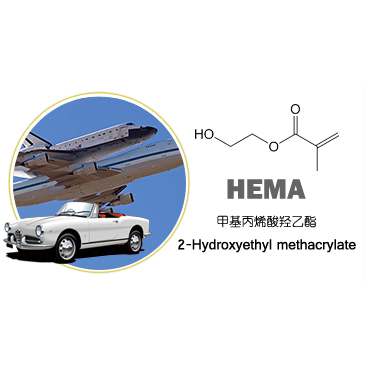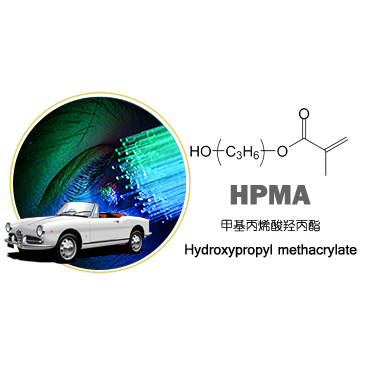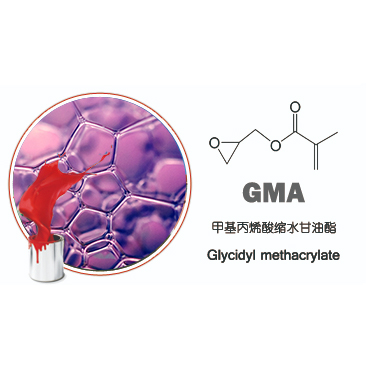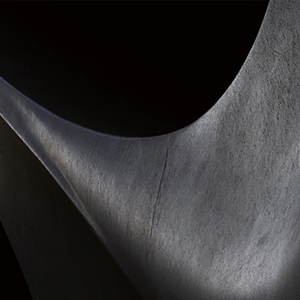- E-mail : info_marketing@jindunchemical.cn
- Phone : +86 21 64057580
- Address : Shanghai China
Glycidyl methacrylate and its application
Glycidyl Methacrylate (GMA) is a monomer that has both an acrylate double
bond and an epoxy group. The acrylate double bond is highly reactive and can
undergo self-polymerization and copolymerization with many other monomers, while
the epoxy group can react with hydroxyl, amino, carboxyl or anhydride groups to
introduce more functional groups and thus bring more functionality to the
product. Therefore, GMA has a wide range of applications in organic synthesis,
polymer synthesis, polymer modification, composite materials, UV-curable
materials, coatings, adhesives, leather, chemical fiber, paper and printing and
dyeing, etc.
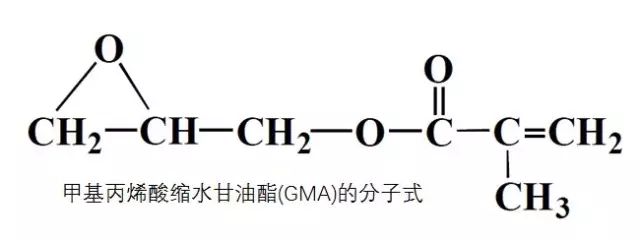
Technical specifications of GMA
The CAS number of GMA is 106-91-2, molecular weight 142.15, density 1.068@25ºC, 粘度2.7cps@15.5ºC, boiling point 189ºC, flash point 85ºC, refractive index 1.4473. It is a colorless transparent low viscosity liquid at room temperature, soluble in common organic solvents, insoluble in water. Due to the epichlorohydrin that will be used in the production process, there is usually a small amount of epichlorohydrin residue in the product.
GMA has a typical taste of acrylate and is irritating to the skin and eyes. Both liquid and gas are flammable. Polymerization reactions may occur at higher temperatures, so a polymerization inhibitor must be added.
Synthesis of GMA
The synthesis of GMA is usually performed by a one-step method with phase transfer or a two-step method with closed-loop esterification.
The one-step method is simple in operation and short in reaction time, but requires the entire reaction system to be water-free, requires high purity of sodium salt, and has the disadvantages of excessive amount of epichlorohydrin and complicated subsequent treatment. The one-step process is used by most of the companies such as Dow in USA and Runao Chemical in China. One-step process is to make sodium methacrylate by neutralizing methacrylic acid and sodium hydroxide or sodium carbonate in organic solvent, and then dry it in the presence of phase transfer catalyst, and then react with epichlorohydrin in a certain proportion by dehydration, high temperature, distillation under reduced pressure and water washing to get GMA products.
The two-step method is to firstly open the ring of methacrylic acid and epichlorohydrin under the action of ring-opening catalyst to produce 2-hydroxy 3-chloropropyl methacrylate. The 2-hydroxy 3-chloropropyl methacrylate is then subjected to a closed-loop reaction of dechlorination in the presence of sodium hydroxide solid or aqueous solution, or reflux in an acetone solution of potassium carbonate to obtain the product.
The application of GMA in powder coatings
Acrylic powder coating is one of the major categories of powder coatings, which can be divided into: hydroxy acrylic resin, carboxyl acrylic resin, glycidyl acrylic resin and acyl amino acrylic resin according to the different curing agents used. Among them, glycidyl acrylic resin is the most used powder coating resin, can be used with polyhydroxy acid, polyamine, polyol, polyhydroxy resin, hydroxy polyester resin and other curing agents to form a film.
Usually methyl methacrylate, glycidyl methacrylate, butyl acrylate and styrene are used for free radical polymerization to synthesize GMA type acrylic resin, and dodecyl dibasic acid is used as curing agent, and the prepared acrylic powder coating has good performance. The synthesis process can use benzoyl peroxide (BPO) and azo diisobutyronitrile (AIBN) or their mixtures as initiators. the effect of GMA dosage on the coating film properties is very significant. If the dosage is too small, the crosslinking degree of resin is low, the curing crosslinking point is small, the crosslinking density of the coating film is not enough, and the impact resistance of the coating film is poor.
Application of GMA in polymer modification
GMA can be grafted to polymers due to the presence of a double bond with a high active acrylate, and the epoxy group with GMA can react with a variety of other functional groups to form functionalized polymers. GMA can be grafted onto modified polyolefins by solution grafting, melt grafting, solid phase grafting, irradiation grafting, etc., and can also form functionalized copolymers with ethylene and acrylates. These functionalized polymers can be used as toughening agents to toughen engineering plastics or as bulking agents to improve the compatibility of the blended system.
GMA graft modification of polyolefin commonly used initiator is diisopropylbenzene peroxide (DCP), but some people use benzoyl peroxide (BPO), acrylamide (AM), 2,5-di-tert-butylperoxy-2,5-dimethyl-3-hexyne (LPO) or 1,3-di-tert-butylperoxyisopropylbenzene initiators. Among them, AM has a significant effect on reducing the degradation of polypropylene when used as initiator. GMA grafting of polyolefins leads to changes in the structure of polyolefins, resulting in changes in surface properties, rheological properties, thermal properties, and mechanical properties of polyolefins. Due to the change of polymer structure after GMA modification, it also affects the crystalline and mechanical properties.
Application of GMA in resin copolymerization
Arkema's LOTADER series is a random copolymerization of ethylene, acrylate and GMA, with a maximum GMA content of 8%. They are very compatible with polyolefin products and have excellent bonding to a wide range of polymers, metals, paper and glass.
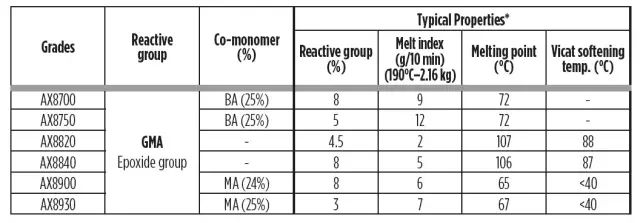
The terpolymer of GMA and styrene and acrylonitrile can be used as chain extender for recycled materials such as PA, PC, PBT and PET, matting agent for alloys such as PC/ABS, PA/ABS and PBT/ABS, and compatibility agent for alloys such as ABS/PBT, ABS/PET and PC/ABS.
Application of GMA in UV-curable resin synthesis
GMA can be used in the synthesis of UV light-curable resins by various synthetic routes. One method is to first obtain prepolymers containing carboxyl or amino groups in the side chain by free radical polymerization or condensation polymerization, and then react GMA with these functional groups to introduce light-sensitive groups to obtain light-curable resins. In the first copolymerization step, different copolymer monomers can be used to obtain polymers with different final properties. Feng Zongcai et al. used 1,2,4-trimellitic anhydride and ethylene glycol to synthesize hyperbranched polymers, and then introduced photoreceptor groups through GMA to obtain light-curing resins with good alkali solubility. Lu Tingfeng et al. used poly(adipic acid-1,4-butanediol), toluene diisocyanate, dihydroxymethylpropionic acid and hydroxyethyl acrylate to first synthesize prepolymers with photosensitive active double bonds, and then introduced more light-curable double bonds by GMA, and neutralized by triethylamine to obtain aqueous polyurethane acrylate emulsions.
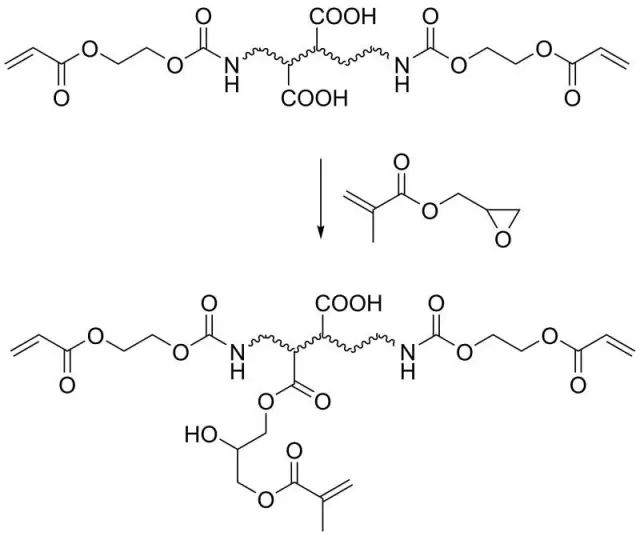
Another method is to first copolymerize GMA and other monomers to obtain copolymers with epoxy functional groups in the side chains, and then react with epoxy functional groups by acrylic acid or methacrylic acid to obtain resin products with light-curing activity.
Application of GMA in UV-curable powder coatings
UV-curable powder coating is a new technology that combines UV-curable technology and traditional powder coating curing technology. It combines the advantages of UV-curable and powder coating and is widely used in the coating of materials such as medium density fiberboard (MDF) and metals.
UV-curable powder coatings can be produced by first synthesizing carboxyl-type polyesters, followed by the reaction of GMA and terminal carboxyl groups to produce UV-curable powder coatings with light-sensitive groups. Xiong Wei et al. used p-dihydroxymethylcyclohexane and adipic acid to generate end-carboxylated polyester resins by esterification reaction, and Zhou Shibiao et al. used free radical copolymerization of methyl methacrylate, ethyl acrylate and butyl acrylate to obtain prepolymers containing carboxyl groups. These prepolymers were then reacted with GMA to introduce photoactive groups.

Application of GMA in macroporous polymers
Macroporous copolymers can be synthesized by suspension polymerization using GMA as monomer, diethylenebenzene (DVB) and/or triallyl isocyanurate (TAIC) as crosslinker, and toluene and n-heptane, etc. as porogenic agents.
Since the macroporous polymers have reactive epoxy groups, they can be easily chemically modified to prepare various adsorbents by solid-loading ligands. For example, polymyxin can be solidly loaded to treat hyperlipidemia, and ornithine can be solidly loaded to treat systemic lupus erythematosus. The macroporous polymers can also be functionalized with mannitol to obtain adsorbents with polyhydroxyl groups.
In addition to the above applications, GMA can also be used in adhesives, UV pressure-sensitive adhesives, automotive coatings, water-based coatings, and other applications. Overall, the glycidyl methacrylate (GMA) itself has an acrylate double bond and an epoxy group, which makes it very versatile.
JIDNUN Chemical has been engaged in the production and sales of light-curing raw materials, with a 56,800 square meter production base in Shandong, a 600 square meter R&D lab and a 300 square meter application lab in Jiangsu.
JINDUN Chemical provides high quality glycidyl methacrylate (GMA), the quality of which is comparable to similar foreign products, and some indexes even exceed those of foreign products.
-
date
2022-10-10
-
location
Shanghai, China






































